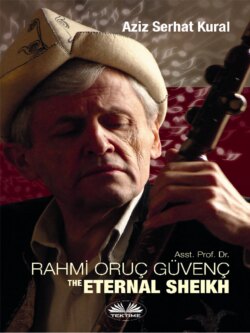Читать книгу ASST. PROF. DR. RAHMI ORUC GUVENC - Aziz Serhat Kural - Страница 4
ОглавлениеHOW I MET ORUÇ GÜVENÇ
Believe me, it never occurred to me that I would write this book. In fact, when the thought of writing a book about Oruc Guvenc first came to my mind, I asked my friend Emre Basaran, a close associate of Mr. Oruc Guvenc in his musical and spiritual endeavors, whether he might carry out such a project. In reply, he told me that it would be more appropriate if I took care of the matter.
That is why I would like to start with how I met Oruc Bey. It was either 1979 or 80 and I was playing in a chess tournament. A long time has passed since then, so I don’t remember exactly which tournament it was, but I think it was the Musa Tebi Memorial Tournament, where I finished among the top three and received a small monetary prize. At this tournament, I was playing against Ali Ipek, who later went on to win the FIDE Master title1.
Ali made a sidelong attack from his King’s side, deftly capturing my Castle with his Bishop. At that point, I believe he thought he had won the game. But after he captured my Castle, I was able to retrieve the pieces I had lost and improve my position with a particular pawn move. Ali, surprised by my pawn maneuver, had to think long and hard as to what to play next. In the end the game was adjourned. In the late 70s and early 80s there was no internet or personal computers, and smart phones were not yet available. In those days, if a chess game took too long, it was adjourned and continued at a later date determined by the referee. However nowadays, since it is possible to analyze a game with computers, with a few modifications the ‘Guillotine’ or ‘Sudden Death’ system is applied, whereby a player who exceeds the time limit immediately loses the game. Anyway, the game was adjourned, and I was one pawn up. I went home and realized that, despite being a pawn up, I was losing in a problematic fashion. However, I was aware that my opponent might not be able to see this because any normal analysis would have indicated that I was winning.
With many thoughts in my mind, I arrived at the chess center on the day the game was to resume. Ali had also come. We talked and decided between us that the game should end in a draw, without further play. Afterwards, when Ali commented that I could have won, I showed him the intricate moves he could have made to win. He was amazed and sat lost in thought for a while. He then said he wanted to take me somewhere. On the way, he told me that he wanted to introduce me to a Sufi Master.
At that time, I was totally unaware that the ensuing interaction would totally and profoundly affect the rest of my life. On the bus, Ali explained that this person was a great Master and an expert in Sufism, Music and Turkhood. Finally, we arrived at Oruc Bey2’s 3-storied timber villa in Kadirga. If I remember correctly, Ali had a key. We went inside. There was a wooden staircase to the left of the entrance that went up to the first and second floors. The first floor was used most of the time and the rooms on the upper floors were used for specific purposes. We stayed on the first floor where musical instruments were hanging from all the walls, some of which I had never seen before. Some instruments that I found most intriguing lay on the floor looking like mere boxes covered with lots of taut strings, which I later learned to be Indian instruments. It was there, on the first floor, that I first met Oruc Bey.
During a conversation with Oruc Bey
I shall never forget how, on reaching the first floor, we entered the room on the right where I saw him playing ‘El Condor Pasa’ to me on a Shakuhachi (a Japanese flute made from bamboo). I immediately warmed to him and that has continued to increase to this day. It would be no exaggeration to say that our Sheikh-disciple relation started at that very moment.
That evening, or in the following days I don’t quite remember, Ali explained why he took me to meet Oruc Bey. He said that, after the match I mentioned earlier, he had experienced a chronic headache for which aspirin and similar medication did little to help, so he had gone to consult Oruc Bey. According to Ali, Oruc Bey had explained the reason for the headache as follows: “A knot formed in your mind when you thought you had lost your Bishop while playing chess against a long-haired boy with a light beard. This is the reason for your headache. Bring that boy to me, whenever it is convenient for you.”
Yes, that is how I met Oruc Bey, but this book is about Oruc Bey. If this book attracts attention and if there is demand, I would very much like to write about my apprenticeship with him. But my aim in this book is to outline the life and works of Rahmi Oruc Guvenc and provide insight into his teachings. I have no wish to crowd the book with details like dates, places and names.
1 A Master Title of the International Chess Federation (FIDE)
2 ‘Bey’ is used as ‘Mr.’ or ‘Sire/Sir’ in Turkish. However, note that it follows the first name instead of the surname, as in the West.
